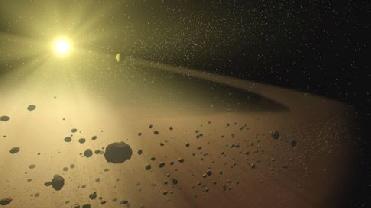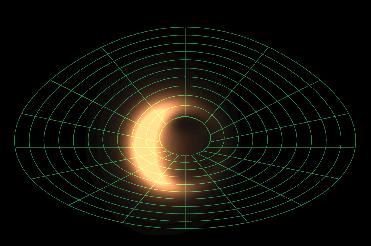
WASHINGTON, DC (BNS): Between five and 10 percent of Near Earth Objects (NEOs) could be comets impersonating as asteroids, says Paul Abell, who is finding ways to unmask them. NEOs are objects whose orbits bring them in close proximity to Earth.
Some NEOs could be dying comets, those that have lost most of the volatile materials that create their characteristic tails. Others could be dormant and might again display comet-like features after colliding with another object, said Abell, a Houston, Texas-based research scientist with the Planetary Science Institute.
Under a recently awarded NASA grant, Abell is using NASA's Infrared Telescope Facility at the Mauna Kea Observatories in Hawaii and the MMT telescope on Mount Hopkins, south of Tucson, Arizona, to uncover observational signatures that separate extinct/dormant comets from NEOs.
This is important for a couple of reasons. First, dormant comets in near-Earth space could become supply depots to support future exploration activities with water and other materials. Second, like other NEOs, they could pose a threat to Earth if they are on a collision course with our planet. Third, they can provide data on the composition and early evolution of the Solar System because they are thought to contain unmodified remnants of the primordial materials that formed the Solar System.
Unlike rocky asteroids that blast out craters when they slam into Earth, comets are structurally weak and likely to break up as they enter the atmosphere, leading to a heat and shockwave blast that would be much more devastating than the impact from an asteroid of the same size.
Low-activity, near-earth comets flashed onto the planetary-science radar screen in 2001, when the Lowell Observatory Near Earth Asteroid Search telescope discovered NEO 2001 OG108. It had an orbit similar to comets coming in from the Oort Cloud and was first thought to be one of the Damocloids, asteroids that have Comet Halley-type orbits, but no cometary tails.
Several groups began monitoring 2001 OG108 because it looked suspiciously comet-like. Serendipitously, it gave them a look at, and data on, a bare comet nucleus, an extremely unusual observation. The nuclei of comets are very dark and difficult to observe when they're far from Earth. When they come closer to Earth, the sun's heat vaporises some of the comet's ice creating the clouds of dust and gas that make up the comet's coma and tail, which shroud the nucleus from view.
The coma is a bright cloud of dust and gas at the head of the comet, with the tail trailing out away from the Sun. In early 2002, NEO 2001 OG108 lit up with a coma and it was re-classified as C/2001 OG108 (LONEOS).
"That's what started me on this line of reasoning and scientific investigation," Abell said.
Abell and Faith Vilas, director of the MMT Observatory and an affiliate senior scientist at the Planetary Science Institute, will be working in the visible (0.35 - 1.0 microns) and near-infrared (0.7 to 2.5 microns) spectral ranges.
"Hopefully, by combining data from these two wavelength regions, we may be able to find some signal or some observational discriminator that will help us identify whether something is an extinct comet or just an asteroid," Abell said.
Abell hopes the data will show different spectral signatures for objects that originate in the Oort Cloud, the Kuiper Belt, and the recently discovered main-belt comets that come from the asteroid belt between Mars and Jupiter. The Oort Cloud is located far out beyond Pluto and the Kuiper Belt is beyond Neptune, but only 1,000th the distance of the Oort Cloud from the Sun.
"Are all these comets made of the same type of material or are they different?" Abell asked. "If they're composed of different materials, they may have different spectral signatures, and our preliminary work on Jupiter-family comets and Halley-type comets shows that this may be true. Why is that? Is it something to do with the initial conditions of their formation regions? Or is it due to the different environments in which they spend most of their time?"
"All this is important to understanding their internal makeup, which will give us data on the material composition and evolution of the early solar system," he added.
By combining orbital data with spectra and the albedos (brightness) of these objects, Abell hopes to identify which are low-activity comets and where they are coming from.
 Next Article
Next Article













The Indian Air Force, in its flight trials evaluation report submitted before the Defence Ministry l..
view articleAn insight into the Medium Multi-Role Combat Aircraft competition...
view articleSky enthusiasts can now spot the International Space Station (ISS) commanded by Indian-American astr..
view article